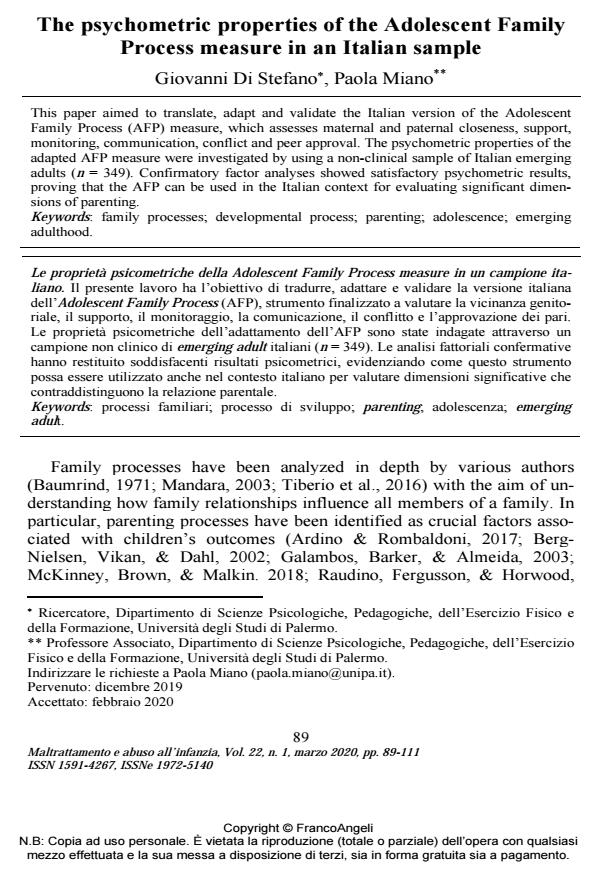The psychometric properties of the Adolescent Family Process measure in an Italian sample
Titolo Rivista MALTRATTAMENTO E ABUSO ALL’INFANZIA
Autori/Curatori Giovanni Di Stefano, Paola Miano
Anno di pubblicazione 2020 Fascicolo 2020/1
Lingua Inglese Numero pagine 23 P. 89-111 Dimensione file 332 KB
DOI 10.3280/MAL2020-001007
Il DOI è il codice a barre della proprietà intellettuale: per saperne di più
clicca qui
Qui sotto puoi vedere in anteprima la prima pagina di questo articolo.
Se questo articolo ti interessa, lo puoi acquistare (e scaricare in formato pdf) seguendo le facili indicazioni per acquistare il download credit. Acquista Download Credits per scaricare questo Articolo in formato PDF

FrancoAngeli è membro della Publishers International Linking Association, Inc (PILA)associazione indipendente e non profit per facilitare (attraverso i servizi tecnologici implementati da CrossRef.org) l’accesso degli studiosi ai contenuti digitali nelle pubblicazioni professionali e scientifiche
This paper aimed to translate, adapt and validate the Italian version of the Adolescent Family Process (AFP) measure, which assesses maternal and paternal closeness, support, monitoring, communication, conflict and peer approval. The psychometric properties of the adapted AFP measure were investigated by using a non-clinical sample of Italian emerging adults (n = 349). Confirmatory factor analyses showed satisfactory psychometric results, proving that the AFP can be used in the Italian context for evaluating significant dimensions of parenting.
Il presente lavoro ha l’obiettivo di tradurre, adattare e validare la versione italiana dell’Adolescent Family Process (AFP), strumento finalizzato a valutare la vicinanza genitoria-le, il supporto, il monitoraggio, la comunicazione, il conflitto e l’approvazione dei pari. Le proprietà psicometriche dell’adattamento dell’AFP sono state indagate attraverso un campione non clinico di emerging adult italiani (n = 349). Le analisi fattoriali confermative hanno resti-tuito soddisfacenti risultati psicometrici, evidenziando come questo strumento possa essere utilizzato anche nel contesto italiano per valutare dimensioni significative che contraddistin-guono la relazione parentale.
Parole chiave:Processi familiari; processo di sviluppo; parenting; adolescenza; emerging adult.
- Preliminary development and psychometrics characteristics of a multidimensional measure of Parental Psychological Control: The Inventory of Parental Psychological Control (IPPC) Francesca Cuzzocrea, Sebastiano Costa, Marco Cannavò, Maria Cristina Gugliandolo, in MALTRATTAMENTO E ABUSO ALL'INFANZIA 2/2020 pp.55
DOI: 10.3280/MAL2020-002004 - Italian validation of the Adolescent Family Process short-form questionnaire Maria Mirandi, Adriana Lis, Claudia Mazzeschi, Elisa Delvecchio, in European Journal of Developmental Psychology /2024 pp.305
DOI: 10.1080/17405629.2023.2285072
Giovanni Di Stefano, Paola Miano, The psychometric properties of the Adolescent Family Process measure in an Italian sample in "MALTRATTAMENTO E ABUSO ALL’INFANZIA" 1/2020, pp 89-111, DOI: 10.3280/MAL2020-001007